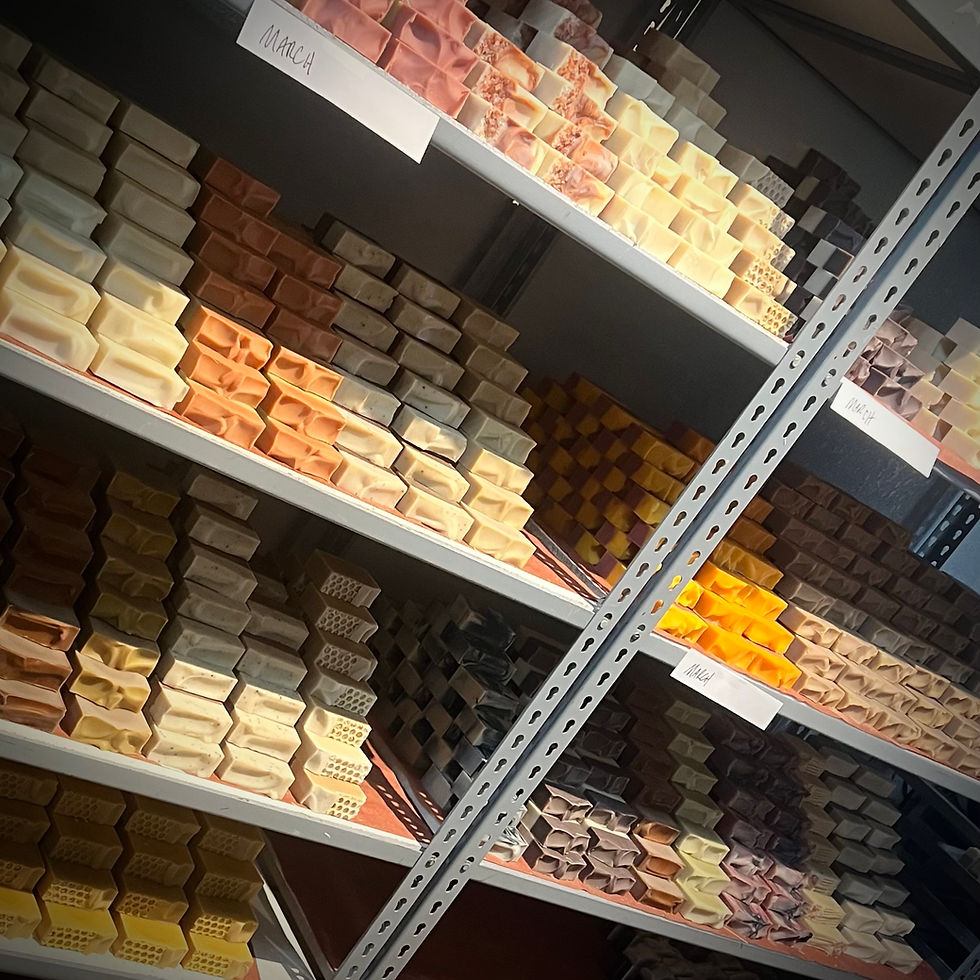The Sudsy Sorcery of Cold Process Soap
- Michael Douglas-Smith
- Oct 29
- 4 min read
Soap making is more than a practical skill; it’s an art that truly shines at Douglas-Smith Soap Company in the magical town of San Marcos, TX.
The cold process method elevates this craft, offering unique benefits that have captivated soap lovers (and soap wizards) everywhere.
Let’s explore the cold process method, the timeline from start to finish, and its hidden perks for enthusiasts and casual users alike.

The Chilling Charm of Cold Process
The term "cold process" describes a soap making technique that does not involve heating. Instead, it utilizes a chemical reaction known as saponification, where a lye solution mixes with oils at room temperature.
This process lets the soap retain the vital qualities of its ingredients. By avoiding heat, the method respects the character of the oils and any additives used, resulting in a finished product that’s as beneficial as it is beautiful.
The beauty of the cold process method is in its simplicity and the control it offers. At Douglas-Smith Soap Co, we carefully choose ans source premium plant oils that are believed to cleanse while nourishing the skin. For example, pure olive oil known for its moisturizing properties and coconut oil prized for its hardening and cleansing abilities as well as castor oil known for its believed bubble stabilizing super powers .
We also add certain ingredients from Mother Nature to demonstrate our creativity. Like essential oils, plant milks, honey, aloe gel and colorants derived from Mother Earth. Our approach delivers not just visually stunning bars but they also support soft, healthy skin.

How Many Waves of the Wand Does it Take?
Cold process soap making is a careful blend of patience and technique. It requires forethought, creativity, preparation and exact measurement.
After emulsifying a lye solution with oils, the soap is poured into a mold, texturized and is then left to saponify for 24-48 hours until it hardens well enough to take out of the mold.
Here’s exactly what happens in that 24-48 hour period:
1. Lye Reacts with Fats/Oils:
Sodium hydroxide (lye) reacts with the triglycerides (fats/oils) in the soap batter, breaking them down into glycerin and fatty acid salts — which are soap molecules.
2. Exothermic Reaction (Heat):
This reaction produces heat, so the soap can feel warm or even hot. If insulated, it may go through the gel phase, where the soap becomes more translucent and has a more vibrant color.
3. Water Begins to Evaporate:
As the soap sits in the mold, some of the water used to dissolve the lye begins to slowly evaporate. This helps the soap harden.
4. Structure Forms:
The oils and lye are now chemically bonding to form a solid bar of soap. The batter thickens, sets, and firms up into a recognizable soap texture.
5. Glycerin Forms:
Glycerin, a humectant that draws moisture to the skin, is formed during saponification and remains in the finished soap (unless removed in commercial processes).

Once solidified, it is removed from the molds and then cut into bars. From here, they are placed on a shelf for a curing phase that lasts about 4-6 weeks.
During this curing time, excess moisture evaporates, creating a firmer and longer-lasting bar. Some even report that this period also allows the pH of the bar to drop to its most mild state before use.
Altogether, the journey from obtaining supplies to mixing and selling usually spans about 6 to 8 weeks.
You can imagine that yes, each Douglas-Smith Soap you purchase has been well thought through and planned for months before you purchase.

What Enchantments Come With It?
The advantages of cold process soap extend beyond just appearance. Here are three reasons we choose the cold-process soap method.
1) Soaps made in the cold-process method are known for being gentler than their commercial counterparts, which often contain artificial ingredients that can irritate the skin. In fact, studies and reports from our customers both show that many users who switch to cold process soap experience less skin irritation and improved skin health than mass-produced cleansers.
2) Using the cold-process, small-batch method, we can create bars tailored for various skin types, whether it’s a moisturizing bar packed with shea butter for dry skin or a scrubbing bar with oatmeal for gentle exfoliation, to an unscented bar with extra skin-loving ingredients for those with sensitive noses. Want to create something unique and personal for yourself? Check out our custom order page on our website!
3) Using a hand made approach to soap making, we can control the ingredients so they are eco-friendly and sustainable. By selling the product direct-to-consumer, we develop a closer relationship with you, allowing you to know who made the soap and to inquire deeper into exactly what's in the soap.
We want our customers to enjoy a thoughtful yet guilt-free, worry-free bathing experience.
The Final Spell
The cold process method may take a little patience, but like any good potion, the magic is in the waiting. With each swirl and scent, we’re not just making soap—we’re casting a little everyday spell of self-care.
Whether you're looking to enhance your self-care routine or searching for a meaningful gift, Douglas-Smith cold process soap offers countless benefits worth exploring.
Want to experience the enchanting cold process method yourself?
Join one of our monthly classes at Douglas-Smith Soap Company in downtown San Marcos, TX.
If you made it THIS far, THANK YOU for reading!
Let us know if you enjoyed this blog by showing us some love and tapping the heart! 💖
Have a topic you'd like to learn more about? We invite you to make your suggestions in the comments below!
Treat Yourself and Your Skin Well,
Michael and Kevin



Comments